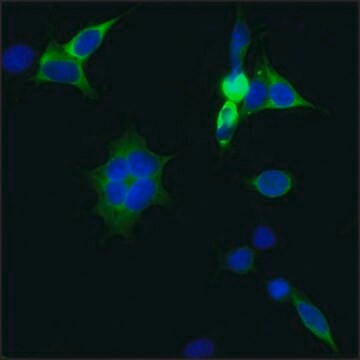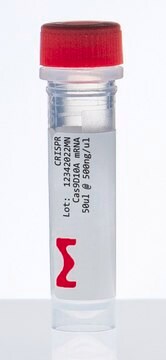CAS9PROT
Cas9 Protein
from Streptococcus pyogenes, recombinant, expressed in E. coli, 1X NLS
Sinônimo(s):
Cas9, SpCas9, SpyCas9
About This Item
Produtos recomendados
recombinante
expressed in E. coli
Nível de qualidade
Ensaio
≥95% (SDS-PAGE)
forma
lyophilized powder
embalagem
pkg of 1 kit (3 components)
aplicação(ões)
CRISPR
Condições de expedição
wet ice
temperatura de armazenamento
−20°C
Descrição geral
Aplicação
Ações bioquímicas/fisiológicas
Características e benefícios
- Highly specific
- Highly active
- Ready-to-inject/transfect
Embalagem
pkg of 250 μg (≥ 1500 pmol)
Componentes
- one vial of Cas9 recombinant protein
- one vial containing 1 mL of 1× dilution buffer
- one vial containing 1 mL of nuclease-free water with glycerol
Princípio
Reconstituição
Outras notas
Check out our other MISSION® Cas9 Proteins at SigmaAldrich.com/CRISPRproteins
Informações legais
Somente componentes do kit
- Cas9-NLS from Streptococcus pyogenes, expressed in Escherichia coli
- Dilution buffer for Cas9 proteins
- Reconstitution solution for Cas9 proteins
Código de classe de armazenamento
10 - Combustible liquids
Ponto de fulgor (°F)
Not applicable
Ponto de fulgor (°C)
Not applicable
Certificados de análise (COA)
Busque Certificados de análise (COA) digitando o Número do Lote do produto. Os números de lote e remessa podem ser encontrados no rótulo de um produto após a palavra “Lot” ou “Batch”.
Já possui este produto?
Encontre a documentação dos produtos que você adquiriu recentemente na biblioteca de documentos.
Os clientes também visualizaram
Protocolos
Sigma-Aldrich® sgRNA, crRNA and tracrRNA come HPLC purified as standard with our performance guarantee—even for custom designs.
The CRISPR (Clustered Regularly Interspaced Short Palindromic Repeats) system was discovered in bacteria, where it functions as an adaptive immune system against invading viral and plasmid DNA.
Combine guaranteed sgRNAs with our comprehensive range of CRISPR products and tools, including Cas9 and delivery reagents, for efficient genome modification with higher specificity.
Conteúdo relacionado
Watch Cas9-GFP proteins work inside your cells and deliver the powerful nuclease editing you have come to trust and expect. MISSION™ SpCas9-GFP and eSpCas9-GFP proteins are multi-functional enzymes with high on-target cleavage efficiency fused to Enhanced Green Fluorescent Protein (EGFP) for real-time observation of Cas9 delivery and clearance from cells.
Nossa equipe de cientistas tem experiência em todas as áreas de pesquisa, incluindo Life Sciences, ciência de materiais, síntese química, cromatografia, química analítica e muitas outras.
Entre em contato com a assistência técnica














